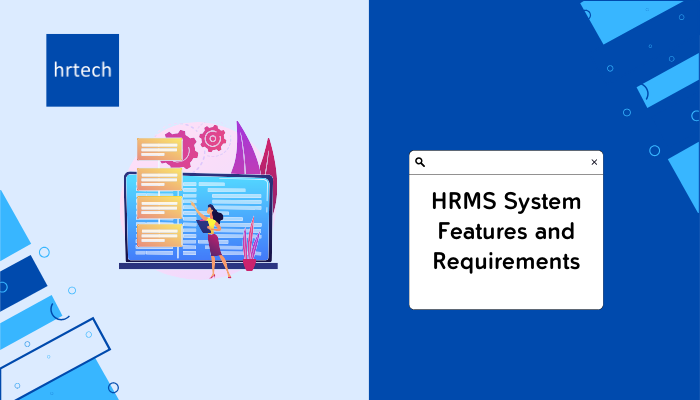Managing human resources in a growing business is no small task. From recruiting top talent to processing payroll and tracking performance, HR departments juggle a range of responsibilities that can quickly become overwhelming. That’s where a Human Resource Management System (HRMS) steps in as a game-changer. But with so many options available, how do you determine which features you actually need?
This is where creating a well-defined HRMS features list becomes crucial. Whether you’re a small business looking to centralize employee records or a larger enterprise aiming to optimize performance management, understanding the key features of an HRMS can make all the difference.
In this guide, we’ll explore the essential features and requirements to help you choose an HRMS that not only streamlines HR tasks but also aligns with your company’s strategic goals. Let’s dive in to find out what makes an HRMS an indispensable tool for your business’s success.
Determining Your HRMS System Needs
Identifying your business requirements and setting both short-term and long-term goals is crucial when selecting the best HRMS solution. Here are some key factors to consider when building your HRMS features list:
1. Streamlining HR Tasks: HR administrators manage numerous responsibilities daily. Implementing HRMS modules to automate tasks and streamline processes allows them to focus on strategic decision-making and employee skill development. For more insights into how technology can optimize HR tasks, check out Top HR Processes Examples with Flowchart.
2. Improving Workplace Communication: Poor communication can impact your bottom line, increasing turnover, delaying decisions, and causing unresolved conflicts. A shared HRMS platform is essential for efficient communication, especially for remote and hybrid teams. Learn about effective communication strategies in Effective Ways to Improve Communication in the Workplace.
3. Actionable Insights: Your HRMS should provide insights from employee performance, turnover rates, and data trends to support effective decision-making. To better understand how HR software can drive decision-making, read How to Enhance HR Decision-Making Through Talent Intelligence.
4. Empowering Employees: An HRMS that gives employees control over their information, performance analytics, and learning management not only saves time but also boosts accountability.
5. Ensuring Compliance: The system should support accurate record-keeping, generate compliance reports, and maintain audit trails, ensuring you meet local, state, and federal labor laws.For compliance-related HR software, refer to Top HR Compliance Software.
6. Scalability: Choose an HRMS that can scale with your business, supporting evolving needs as your company grows.
Building an effective HRMS features list customized to these considerations will help you find a solution that meets your business’s unique needs.
Benefits of implementing an HRMS system in organizations:
Implementing an HRMS system in organizations streamlines HR tasks, automating processes like payroll, attendance tracking, and performance management. This not only improves efficiency but also boosts employee satisfaction by providing a centralized platform for managing benefits and development programs.
| Benefit | Description |
| Increased Efficiency | Automates repetitive tasks, allowing HR teams to focus on strategic initiatives and reduce time spent on administrative duties. |
| Improved Employee Retention | Provides tools for career development and performance management, enhancing employee satisfaction and loyalty. |
| Enhanced Recruitment | Streamlines the hiring process through automated job postings, applicant tracking, and scheduling, leading to faster hires. |
| Data-Driven Decision Making | Offers analytics and reporting capabilities that help HR professionals make informed decisions based on real-time data. |
| Regulatory Compliance | Ensures adherence to labor laws and regulations by automating compliance-related processes and maintaining accurate records. |
| Better Employee Engagement | Facilitates communication and feedback through performance management tools, fostering a more engaged workforce. |
| Cost Savings | Reduces operational costs by minimizing manual processes, errors, and the need for multiple disparate systems. |
| Scalability | Supports organizational growth by easily adapting to changes in workforce size and complexity without significant additional investment. |
HRMS System Key Features
When searching for an HR platform, it’s important to consider the most essential modules to meet your HR management needs. Here are the top features to look for:
1. Employee Database and Directory
A comprehensive employee database is at the heart of any effective HRMS. It serves as a centralized hub for all employee information, making it easy for HR teams to access, update, and manage data securely. A well-organized database reduces administrative overhead and enhances accuracy in tracking employee records.

Employee Records Management:
Managing employee records efficiently is crucial for smooth HR operations. An HRMS provides a secure, centralized location for storing comprehensive employee information, ranging from personal details to performance reviews.
- Key Benefits: Stores essential employee data such as job history, salary, benefits, tax details, and personal information.
- Efficiency Boost: Reduces paperwork and manual errors, ensuring accurate record-keeping. This can save HR teams up to 40% of the time usually spent on administrative tasks.
- Quick Access: Simplifies data retrieval for HR teams, leading to faster decision-making and improved compliance.
For more information on employee database software, explore Best Employee Database Software.
Organizational Hierarchies:
Understanding the structure of your organization is vital for efficient workflow. This feature helps map out the company’s structure, defining reporting lines, team compositions, and departmental roles.
- Visualization: Displays the company structure, aiding in managing promotions, transfers, and team changes.
- Enhanced Communication: Helps new hires quickly understand company dynamics, reducing onboarding time by up to 25%.
- Cross-Departmental Efficiency: Enhances inter-departmental communication, ensuring that employees have a clear understanding of who to contact for various issues.
Document Management:
Managing essential documents like contracts and tax forms is a critical HR task. An HRMS streamlines this process by providing a centralized repository for secure document storage and easy access.
- Storage: Organizes important documents such as employment contracts, policy handbooks, and tax forms.
- Security: Provides role-based access control to ensure only authorized personnel can access sensitive documents.
- Compliance: Automates notifications for document updates, maintaining compliance and reducing the risk of penalties.
Additional Capabilities:
- Access Control: Enhances data security by limiting document access based on user roles, reducing the risk of unauthorized access by 60%.
- Document Search and Sharing: Facilitates quick retrieval and sharing of documents, reducing reliance on manual processes and enhancing workflow efficiency.
2. Recruitment and Onboarding
The recruitment and onboarding module streamlines the hiring process, helping HR teams attract and retain top talent. By automating routine tasks, HR can focus more on selecting the right candidates and providing a smooth onboarding experience.
Job Posting Management:
Effective job posting is crucial for attracting a diverse pool of candidates. An HRMS simplifies this by allowing you to post job openings on multiple platforms from one centralized system.
- Broader Reach: Posts job vacancies across job boards, social media, and the company website, increasing candidate diversity by up to 30%.
- Time-Saving: Streamlines job postings, reducing the time-to-hire by 50%, a key consideration in any HRMS features list.
To dive deeper into recruitment tools, check out Best AI Recruiting Tools.
Applicant Tracking System (ATS):
An ATS simplifies the recruitment process by tracking candidates through every hiring stage. By automating resume screening, HR can focus on the most suitable candidates.
- Automated Screening: Tracks candidates from application submission to selection and automatically screens resumes based on predefined criteria.
- Effort Reduction: Reduces manual review time by up to 75%, significantly enhancing HR productivity.
- Enhanced Decision-Making: Provides data-driven insights on candidate sourcing and hiring patterns, ensuring more informed recruitment strategies.
Interview Scheduling:
Coordinating interviews can be time-consuming. This feature integrates with calendars and sends automated reminders, providing a seamless interview process.
- Efficiency: Synchronizes with calendars to streamline interview scheduling, reducing scheduling conflicts by 40%.
- Automated Notifications: Sends reminders to candidates and interviewers, improving the candidate experience and employer brand.
Orientation for New Hires:
A positive onboarding experience is key to employee retention. The HRMS provides digital resources, training modules, and checklists to guide new employees through a structured introduction to the company.
- Digital Resources: Offers training modules, policy documents, and a detailed onboarding checklist.
- Boost Retention: Enhances retention rates by up to 69% in the first three years.
- Structured Onboarding: Reduces the time it takes for new hires to reach full productivity by 20%.
Additional Capabilities:
- Background Screening: Conducts automatic checks to verify candidate backgrounds, speeding up the vetting process.
- Automated Email Notifications: Keeps candidates informed at each stage of the process, enhancing the overall hiring experience.
3. Time and Attendance Management
Managing employee time and attendance is vital for payroll accuracy and productivity. An HRMS simplifies this process through tools for precise time tracking, leave management, and attendance reporting.

Time Tracking Mechanisms:
Accurate time tracking is essential for payroll and productivity. The HRMS employs various methods, such as mobile tracking and biometric scanners, to record work hours accurately.
- Multiple Methods: Offers mobile tracking, clock-in/out systems, and biometric scanners to reduce time theft by up to 25%.
- Automation: Generates timesheets automatically, saving HR time on manual entries.
- Fair Compensation: Ensures accurate tracking of work hours for proper employee compensation.
Leave Management:
Managing leave requests can be tedious. The HRMS streamlines the process, allowing employees to request leave directly, with managers approving in real-time.
- Simplified Process: Employees can submit leave requests directly in the system, with instant updates to their leave balances.
- Transparency: Provides managers with real-time visibility into leave statuses, reducing leave conflicts by 35%.
- Compliance: Tracks leave balances to ensure compliance with company policies and labor laws.
Attendance Reports:
Attendance reports provide insights into employee work patterns, absenteeism, and overtime. These reports are crucial for data-driven decisions.
- Detailed Insights: Generates reports on attendance, absenteeism, and overtime, aiding in optimizing staffing levels.
- Integration: Seamlessly integrates with payroll for accurate compensation calculations.
- Data Analysis: Offers insights to identify and address productivity issues.
Additional Capabilities:
- Overtime Tracking: Monitors extra work hours, ensuring proper and fair compensation.
- Automated Notifications: Alerts employees and managers about leave approvals and attendance discrepancies, keeping everyone informed.
4. Payroll and Compensation Management
Payroll processing is one of the most complex HR tasks. An HRMS automates this process, ensuring timely and accurate payments while complying with tax regulations. Efficient payroll and benefits management can significantly impact employee satisfaction and retention.
Payroll Processing Automation:
Automating payroll calculations minimizes errors and ensures employees are compensated correctly. This feature includes salary, overtime, deductions, and tax calculations.
- Accurate Calculations: Automates salary, tax withholdings, and bonuses, reducing payroll errors by up to 85%.
- Timely Payments: Ensures on-time salary processing, improving employee satisfaction.
- Integration: Integrates with time-tracking mechanisms for seamless payroll processing.
Employee Benefits Administration:
Managing benefits like health care and retirement plans is essential for employee satisfaction. The HRMS simplifies enrollment and tracking, allowing employees to manage their benefits with ease.
- Self-Service: Employees can enroll in benefits directly through the system, giving them more control over their options.
- Improved Retention: Simplifies benefits administration, contributing to higher job satisfaction and retention rates.
- Tracking: Monitors eligibility and enrollment periods, ensuring compliance with company policies.
Compliance with Tax Regulations:
Ensuring compliance with tax regulations is crucial to avoid legal issues. The HRMS automates tax filings and stays updated with changing laws, reducing compliance risks.
- Automatic Updates: Keeps up-to-date with the latest tax laws, ensuring compliance with local, state, and federal regulations.
- Risk Reduction: Automates tax calculations and filings, minimizing the risk of penalties and errors.
- Reports: Generates compliance reports for auditing, offering peace of mind to businesses.
Additional Capabilities:
- Pay Stub Generation: Provides detailed pay stubs accessible through the self-service portal.
- Custom Earning Codes: Supports different compensation structures, including bonuses and commissions, catering to diverse business needs in an HRMS features list.
5. Performance and Appraisal Management
Effective performance management is key to employee development and company growth. This module facilitates comprehensive evaluations, feedback, and development plans to help employees align with organizational objectives.
360-Degree Performance Reviews:
Gathering feedback from multiple sources offers a holistic view of employee performance. This approach supports continuous development by identifying strengths and areas for improvement.
- Multi-Source Feedback: Collects input from managers, peers, and self-assessments for a well-rounded evaluation.
- Continuous Improvement: Helps identify training needs, boosting employee performance by up to 14%.
- Data-Driven Decisions: Uses gathered data to inform development plans and goal-setting.
Manager and Peer Reviews:
Structured reviews from supervisors and colleagues ensure fair and consistent evaluations. The HRMS automates the review cycle, sending reminders and offering templates to standardize feedback.
- Standardization: Provides templates for structured feedback, ensuring consistency in evaluations.
- Automation: Automatically schedules review cycles, sending reminders to managers and peers.
- Employee Growth: Supports ongoing employee development through regular feedback.
Development Plans:
Creating personalized development plans post-performance evaluations helps employees grow within the company. This feature aligns employee goals with company objectives, fostering a culture of continuous improvement.
- customized Plans: Develops personalized growth plans based on performance reviews.
- Progress Tracking: Tracks progress over time, providing access to training resources.
- Alignment: Ensures employee goals align with the company’s strategic objectives, enhancing engagement and productivity.
Additional Capabilities
- Goal Monitoring: Tracks individual and team goals to promote continuous improvement.
- Feedback Reports: Generates performance reports, supporting data-driven HR decisions.
By understanding and utilizing these key components in your HRMS features list, you can select a system that streamlines HR processes, boosts productivity, and ensures compliance. This structured approach will help support your organization’s growth and employee engagement effectively.
Conclusion
No matter the size or industry of your business, having a Human Resource Management System (HRMS) is crucial for streamlining HR tasks. An HRMS automates processes like payroll and time tracking, significantly boosting efficiency. Beyond the basics, modern businesses can benefit from advanced features such as learning management systems, performance analytics, and integrated accounting tools.
Selecting the right advanced hrms features list can be challenging, as each offers unique benefits. The best way to start is by evaluating your specific business needs, which makes the decision-making process easier and more customized to your organization.
Still unsure which HRMS features would best suit your company? hrtech will help! Contact us simply select your top features, and we’ll assist you in finding the best products that match your criteria.
Good luck with your HRMS journey! Which features do you think would matter most to your business? Share your thoughts in the comments below!
————————————————————————————————————





